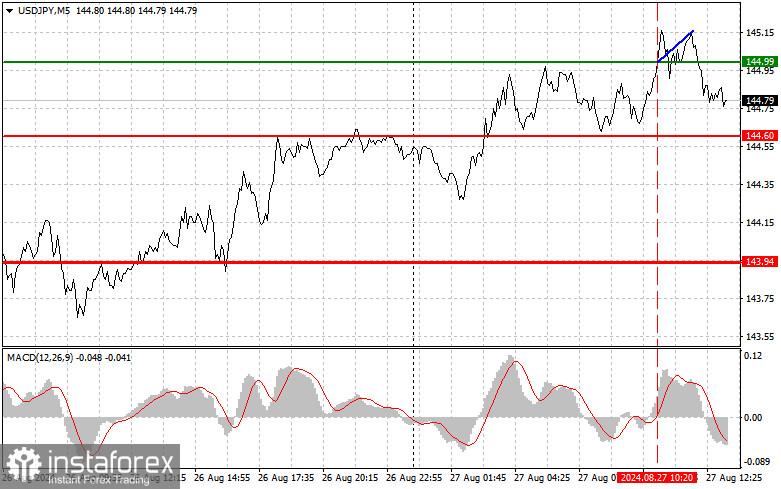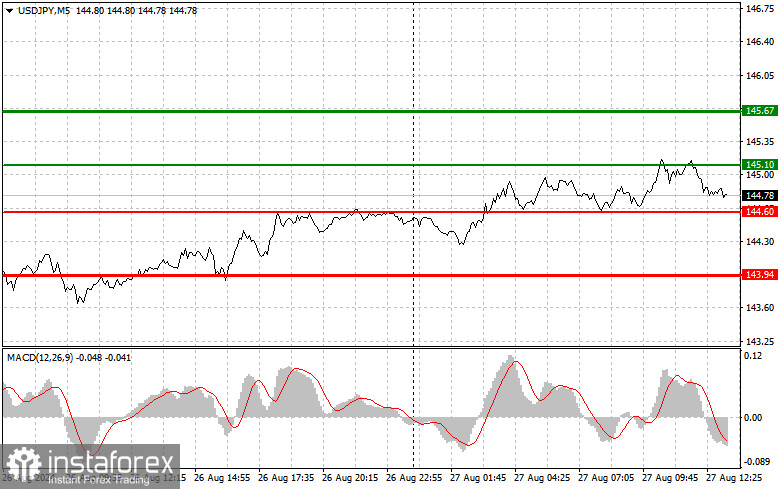Analysis of Trades and Tips for Trading the Japanese Yen
The test of the 144.99 price level occurred when the MACD indicator had just started moving upward from the zero line, confirming it as a valid entry point for buying the dollar. As a result, the pair moved about 15 points before stalling. The second retest of the 144.99 level prompted me to exit the market. The U.S. Consumer Confidence Index, Richmond Fed Manufacturing Index, and S&P/Case-Shiller Home Price Index for the 20 largest cities are what await us in the second half of the day, and these could significantly impact the dollar's upward potential. Only very strong U.S. statistics will sustain the possibility of breaking beyond the daily high. For the intraday strategy, I plan to follow scenarios #1 and #2.
Buy Signal
Scenario #1: Today, I plan to buy USD/JPY at the entry point around 145.10 (the green line on the chart) with a target of rising to 145.67 (the thicker green line on the chart). At 145.67, I will close buy positions and open sell positions in the opposite direction, anticipating a movement of 30-35 points from this level. The pair is likely to rise today only with very strong U.S. statistics, but this is unlikely. Important! Before buying, ensure the MACD indicator is above the zero line and beginning to rise.
Scenario #2: I also plan to buy USD/JPY today if there are two consecutive tests of the 144.60 price level when the MACD indicator is in the oversold zone. This will limit the pair's downward potential and trigger an upward market reversal. A rise toward the levels of 145.10 and 145.67 can be expected.
Sell Signal
Scenario #1: I plan to sell USD/JPY today after it drops below the 144.60 level (the red line on the chart), leading to a quick decline in the pair. The key target for sellers will be the 143.94 level, where I will close sell positions and immediately buy USD/JPY again, expecting a reversal of 20-25 points from this level. Pressure on the pair will return if there is a failed attempt to rise above the daily high, despite strong consumer confidence data. Important! Before selling, ensure the MACD indicator is below the zero line and beginning to decline.
Scenario #2: I also plan to sell USD/JPY today if there are two consecutive tests of the 145.10 price level when the MACD indicator is in the overbought zone. This will limit the pair's upward potential and trigger a downward market reversal. A decline to the levels of 144.60 and 143.94 can be expected.

What's on the chart:
- Thin green line: The entry price at which you can buy USD/JPY.
- Thick green line: The presumed price at which you can set a Take Profit or manually take profits, as further growth above this level is unlikely.
- Thin red line: The entry price at which you can sell USD/JPY.
- Thick red line: The presumed price at which you can set a Take Profit or manually take profits, as further decline below this level is unlikely.
- MACD Indicator: When entering the market, it is important to consider overbought and oversold zones.
Important: Beginner traders in the Forex market should be very cautious when making market entry decisions. It's best to stay out of the market before the release of important fundamental reports to avoid sudden price fluctuations. If you decide to trade during news releases, it is advisable to use stop orders to minimize losses. Without stop orders, you can quickly lose your entire deposit. This is especially true if you do not use money management and trade large volumes.
Remember, successful trading requires a clear trading plan, like the one presented above. Spontaneous trading decisions based on the current market situation typically result in losses for an intraday trader.





















